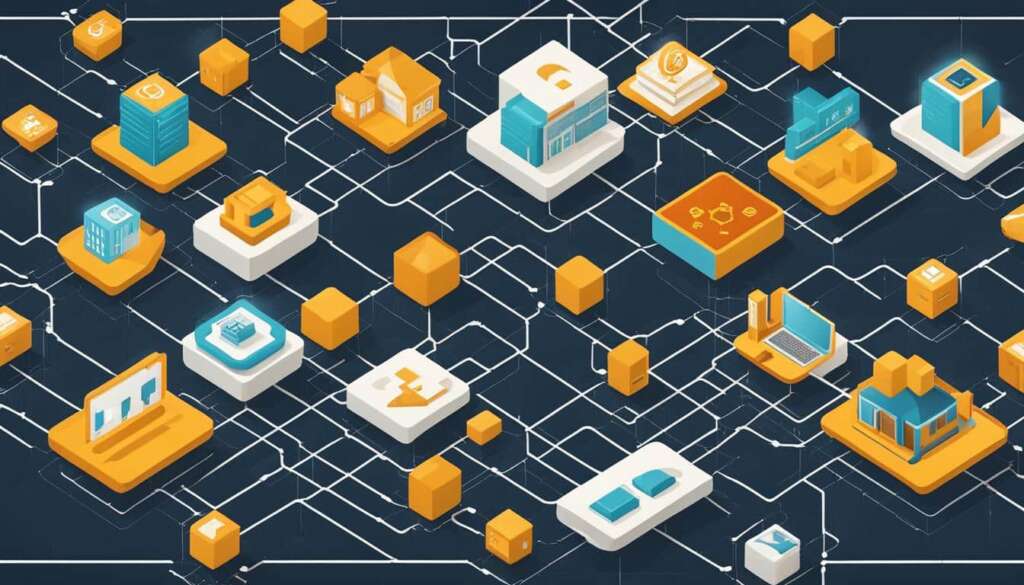Table of Contents
Blockchain technology has changed how we handle data. It’s all about storing, sending, and checking information in a new, secure way. In this article, we aim to help you understand blockchain transactions better. We’ll look at what pending transactions are, why they happen, and how long it takes to confirm them. Plus, we’ll share some tips to make your journey through blockchain smoother and faster.
What are pending transactions in the blockchain? They are transactions waiting to be confirmed and added to the blockchain. When you send something, it goes into a queue of unconfirmed transactions. It waits for people called miners or nodes to check it. The time it takes to get confirmed can vary a lot.
The waiting time for a transaction can be different for each blockchain. The time and size limits of blocks matter a lot. For example, Bitcoin takes about 10 minutes for each block1. On the other hand, Ethereum is quicker, with blocks every 15 seconds2. The size limit of a block can also change how long you wait. Bitcoin, for example, only allows 1 megabyte1.
Some platforms need more checks before they say a transaction is okay. Bitcoin exchanges, for instance, might need three checks1. How much you pay in fees can also make a difference. Miners will look at transactions with higher fees first. So, it might get confirmed quicker1.
Blockchain explorers show the details of your transaction. They can tell you if it’s okay or still waiting. They give you a lot of information like when you sent it, how much, and more. This helps you keep an eye on your transaction from start to finish1.
Some blockchains, like Ripple and Solana, are faster than Bitcoin and Ethereum. But, if there’s too much going on or you pay little in fees, it can take longer. When a lot of people are using the network, you might have to wait more. This is because everyone is trying to get their transactions into the next block1.
You can speed up your transaction with clever moves. In Bitcoin or Ethereum, you can use something called Replace-by-fee. This lets you pay more to have your transaction checked sooner3. For Ethereum, tools like MetaMask can help. They let you make your transaction faster or even cancel it if you need to3.
Key Takeaways
- Pending transactions in blockchain refer to unconfirmed transactions awaiting validation and addition to a block.
- The duration of pending transactions can be influenced by factors such as the block time, block size limit, confirmation requirements, transaction fees, network congestion, and competition for block space.
- Blockchain explorers provide details about pending transactions, allowing users to track their progress.
- Strategies like Replace-by-fee (RBF) and third-party wallets can help optimize transaction speed in specific blockchains.
What are Blockchain Pending Transactions?
A blockchain transaction is data sent from one address to another. It happens on a network of computers. Before a transaction is completed, the network checks it. This check is called confirmation.
Transactions in networks like Bitcoin might face delays. This happens when networks are busy or the fees are low. As a result, the transaction can stay pending for a while.
The mempool is where pending transactions wait. In Bitcoin’s case, the mempool can hold up to 300MB4. If it fills up, some transactions might be delayed further.
Miners are key to confirming transactions. They choose which ones to confirm first, often picking those with higher fees. So, if your fee is low, your transaction might wait longer to be confirmed4.
Bitcoin wallets now suggest fee options. You can choose a fee level depending on how fast you need the transaction done and your budget4.
The Lightning network is a new tech that aims to make transactions quicker. It sits on top of Bitcoin and allows for fast, cheap transfers4. But, bear in mind, opening and closing Lightning channels comes with fees too4.
To understand why transactions are pending, users need to know some details. Soon, we’ll look at why this happens and how long it usually takes for different coins to confirm transactions.
Average Confirmation Times for Selected Blockchains
| Blockchain | Average Confirmation Time |
|---|---|
| Bitcoin | 9 minutes1 |
| Ethereum | 2 minutes1 |
| Litecoin | 2 minutes1 |
| Bitcoin Cash | 10 minutes1 |
| Dogecoin | 1 minute1 |
| Ripple | 4 seconds1 |
The blockchains type and network state affect how long confirmations take1. Ripple confirms in just 4 seconds, but Bitcoin Cash might need 10 minutes1.
Network congestion, low fees, and double-spending can delay transactions1. These issues can make transactions stay pending for longer than expected.
Increase the fee to get a quicker confirmation1. Miners like high fees and will process those transactions first.
Choosing a blockchain with faster confirmation times is another way to speed up your transaction1. Look for a blockchain that processes blocks swiftly.
There are services that can help make transactions faster. They fine-tune the process for quicker confirmations1.
If your fee is too low, your transaction may not confirm at all3. But, some wallets offer a feature to increase the fee later, which can help speed things up3.
Dealing with blockchain pending transactions is a common challenge. Knowing why they happen and ways to make them faster is important. We’ll look into these aspects in more detail later.
Why are Blockchain Transactions Pending?
Blockchain transactions can be pending for several reasons. Network overload and a high number of transactions cause a backlog. This leads to delays in confirming transactions. Detailed data can be found5.
One big reason for pending transactions is network overload. More transactions than the network can handle cause this. As a result, new transactions have to wait their turn, remaining stuck in pending status5.
Transaction fees also affect how long a transaction stays in pending. Miners choose transactions to process based on these fees. Those with lower fees might wait longer to get confirmed5.
For Ethereum transactions, the EVM’s unique characteristics play a part. Transactions on EVM chains can be fast-tracked or canceled by users. But not all blockchain networks offer this flexibility5.
When it comes to Ethereum, gas fees play a key role in pending times. Gas fees are what users pay for their transactions to take place. If these fees are low, miners might not rush to process the transaction5.
Trust Wallet helps Ethereum users deal with this. It allows them to speed up or cancel transactions on EVM chains. Thus, they can avoid long waiting times5.
Once a non-EVM blockchain transaction is ‘PENDING,’ nothing can change it. Users just have to wait for these transactions to be confirmed or expire. No edits or withdrawals are possible5.
On non-EVM chains, unconfirmed transactions are eventually removed. This is to keep the network running smoothly and not clogged up5.
Understanding the Impact of Blockchain Pending Transactions
Blockchain pending transactions affect users and businesses. They slow down the speed of financial operations on the blockchain. This delay underlines the importance of network improvements and growth6.
Compared to traditional banking, blockchains are often much faster. They can process transactions in minutes rather than days. This shows the benefit of blockchain tech in speeding up transactions6.
Each blockchain’s way of keeping secure differs. The methods it uses affect speed, safety, and who controls the network. Knowing these differences helps understand why some blockchains are faster or more secure than others6.
The block size on a blockchain affects how many transactions it can handle. Bigger blocks can process more transactions but might need more from the validators. This impacts how decentralized and fast the network is6.
Most blockchain networks keep transactions anonymous but visible. This raises issues about illegal use and privacy. Finding a good balance is important in these debates6.
Bitcoin is purely public, with no central control, while private blockchains are run by one entity. Consortium blockchains involve several parties. Each has its benefits and is used for different types of transactions6.
Knowing about different blockchains can help us use them better. Understanding their features and effects can improve how we interact with blockchain technology6.
How Long Do Blockchain Transactions Take to Confirm?
The time for blockchain transactions to confirm varies. It depends on the type of blockchain and network. Several factors affect this, including network conditions and the confirmations needed. We will look at how different cryptocurrencies’ confirmation times differ. We’ll also discuss ways to speed up this process.
Bitcoin Confirmation Times
Bitcoin transactions usually take about 10 minutes to confirm7. But, in busy times, it might take even hours or days to get confirmed8. To make it faster, users can pay a higher fee. This higher fee can lead to quicker confirmations8.
One option to speed up Bitcoin transactions is called RBF. This allows users to replace a pending transaction with a new one that has a higher fee. Using RBF can help get Bitcoin transactions confirmed sooner8.
Ethereum and Other Cryptocurrencies
Ethereum and some other cryptocurrencies confirm transactions faster than Bitcoin. Ethereum transactions, for example, take around 2 minutes to confirm7. Because of this, Ethereum is often chosen by those who want quick processing7.
Cryptocurrencies like Litecoin and Ripple are also quicker than Bitcoin. They are good for situations needing fast transaction speeds7.
Checking Transaction Status
Users often want to keep track of their blockchain transactions. Most blockchain explorers let users check their transaction’s progress. By entering the transaction ID or wallet address, users can see how many confirmations their transaction has7.
Optimizing Confirmation Efficiency
To make blockchain transactions work better, consider the needs of the platform or service. For example, Binance needs one confirmation for Bitcoin deposits and two for withdrawals. Coinbase, on the other hand, requires three confirmations for Bitcoin to finalize7.
Be aware that large transfers might need more confirmations for security. This can take longer, up to an hour or more7.
The Lightning Network
The Lightning Network is a solution to Bitcoin’s speed and scale problems. It allows fast, cheap micropayments by taking transactions off-chain. This network of payment channels speeds up and reduces the cost of Bitcoin transactions7.
By looking at the key factors involved in confirming transactions, users can manage the blockchain system better. They can also make their transaction confirmations faster.
How Can I Speed Up My Blockchain Transactions?
To make your blockchain transactions faster, there are steps you can take. Knowing what causes delays and using the right tools will cut down your waiting time. You can get quicker confirmations this way.
- Optimize transaction fees: Topping up your transaction fee speeds things up. Paying a bit more encourages miners to deal with yours first, reducing wait times9.
- Consider faster blockchains: Some blockchains process things quicker based on their block times. Choosing fast ones like Dogecoin or Ripple1 means rapid confirmations for you.
- Utilize Replace by Fee (RBF): With RBF, you can re-send a transaction with a higher fee to get it done quicker9 and8. Premium Bitcoin wallets like Xverse offer this feature, giving you more say in the process9.
- Explore third-party services: Looking into third-party services can also help with fast transactions8. They use special methods to speed things up. Just make sure they’re trusted for your safety.
- Monitor and analyze network conditions: Network status affects your transaction speed8. By looking at blockchain explorers, you can understand better when to move, considering fees and time1.
By following these tips and keeping an eye out for blockchain updates, you can enjoy a smoother and quicker blockchain experience.

How Can I Check the Status of My Blockchain Transactions?
After making a transaction on the blockchain, you naturally want to check its progress. Luckily, there are tools to help you do this. You can easily follow your transactions and see how they’re doing.
A blockchain explorer is a top tool for this. It’s a website or app that lets you see the blockchain’s data. Just put your transaction ID into the explorer, and you’ll get all the details on your transaction.
The transaction ID, or hash, is a unique code for each transaction. It’s like a digital fingerprint. You can use it to quickly find your specific transaction.
With your transaction ID in the explorer, you’ll see lots of info. You can check if the transaction is done or still waiting. Plus, you’ll learn when it started, and see its inputs and outputs.
The explorer will also show you transaction fees and sizes. This helps evaluate your transaction’s cost and speed. It’s great for knowing what fee to use in your future transactions for quick processing.
Using a blockchain explorer gives you a window into the blockchain’s world. You can watch your transaction’s journey. This keeps you informed and ready to act if something goes wrong.
Sometimes, your wallet or exchange can track transactions for you. They offer an easy way to see how your transaction is doing. This spares you from looking through different explorers.
It’s crucial to keep an eye on your blockchain transactions. Tools like blockchain explorers and wallet features make it easier. They help you make sure your transactions go through smoothly.
Source
- – “Blockchain Explorer: Definition and How It Works” by CoinMarketCap
- – “What Is a Blockchain Explorer?” by Binance Academy
Blockchain Confirmation Requirements
Blockchain transactions can vary in the confirmation steps they need to be considered complete. Understanding these steps is key to making sure your transactions go through on time.
Bitcoin needs an average of 10 minutes to mine a block10. In contrast, Nervos’ block time is only 10-12 seconds10. This makes Nervos’ transactions much quicker than Bitcoin’s.
Typically, transactions need three or more confirmations to be fully valid10. This is to make sure they’re secure and can’t be easily changed. Each confirmation just adds more security.
Confirmation times differ for each cryptocurrency. For example, Bitcoin needs around 10 minutes per confirmation11. Ethereum takes 13 to 15 seconds for each block but might need longer due to network issues11. XRP confirms in 3 to 5 seconds thanks to a quick consensus system11. Litecoin needs just 2.5 minutes for each block to confirm11. Bitcoin Cash is about as quick as Bitcoin with 10 minutes per block11.
Many things can affect how long a transaction takes to confirm. This includes how busy the network is, the fees you pay, the block time, how many confirmations are needed, and syncing with other nodes11. Things like increasing the network’s capacity and using new technologies can help make everything faster and smoother11.
Comparing Blockchain Confirmation Times
Let’s compare how different platforms handle confirmation times. Binance requires one block for deposits and two for withdrawals of Bitcoin7. Coinbase needs three blocks to confirm a BTC transaction7. Some big transfers might need up to six confirmations7.
The Lightning Network makes Bitcoin payments faster and cheaper7. Ethereum and Litecoin are already quicker than Bitcoin for confirming transactions7.
Optimizing Blockchain Transactions for Efficiency
To make blockchain transactions better, think about when you need them to confirm, the fees, and how the network works. Picking the right fee matters. In April 2021, the average Bitcoin fee was as high as $597. Tools like Blockchain.com and Statista can help you figure out the best fee7.
Upgrading your hardware and using smart software can also help. They make transactions faster and the network run smoother117.
The number of confirmations needed can change from one service to another. For example, Binance only requires one block for a deposit, but Coinbase wants three blocks for a transaction7. Always check what your platform needs for a problem-free transaction.
Reference Links:
- Transaction Confirmation in Blockchain (Nervos)
- How Long Does Blockchain Pending Take
- How Long Does a Bitcoin Transaction Take
Optimizing Blockchain Transactions for Efficiency
Optimising blockchain transactions involves keeping an eye on network conditions12. This means knowing the blockchain’s current congestion and how fast it’s processing transactions. With this knowledge, users can improve how quickly their transactions are confirmed.
One key strategy is to adjust the transaction fee. When the network is busy, fees go up as people pay more to get their transactions through12. By paying a higher fee, you can make your transaction more appealing to miners, who might confirm it sooner.
Choosing a blockchain platform with quick block times can also help13. Block time is how long it takes for a transaction to be confirmed on the blockchain. Platforms like Ethereum, with fast block times, confirm transactions quicker.
Also, follow the rules set by the platform you’re using. Different coins have rules for which transactions they confirm first, like considering the fees offered. Adhering to these rules makes it more likely your transaction is processed swiftly13.
Improving network setup techniques is crucial too. Things like load balancing and managing data traffic help reduce delays and speed up transactions12. This can lead to quicker confirmations and a smoother network experience.
Monitoring Tools and Transaction Volumes
Keep an eye on monitoring tools for better transaction outcomes. They track things like unconfirmed transactions and fees, helping you choose the right transaction fee. This way, you can guess how long it will take to confirm based on past data14.
The amount of transactions happening is a clue on how busy a business is12. More transactions mean a buzzing activity whereas less might signal problems. It’s a key indicator in figuring out how well a business is doing.
Optimising blockchain transactions is a mix of many practices. These include keeping up with the network, adjusting fees, choosing speedy blockchains, following specific platform rules, and using monitoring for smart decisions121314.
| Optimizing Blockchain Transactions | Benefits |
|---|---|
| Stay informed about network conditions | Make informed decisions for transaction efficiency |
| Adjust transaction fees accordingly | Incentivize miners for higher chances of confirmation |
| Select blockchains with faster block times | Expedite transaction confirmation |
| Understand platform-specific requirements | Streamline transactions based on tailored mempools |
| Utilize monitoring tools | Set appropriate transaction fees and estimate confirmation times |
| Analyze transaction volumes | Gain insights into business activity and performance |
By following these tips, users can make their blockchain dealings smoother and more efficient.
The Future of Blockchain Transactions
Blockchain technology is moving forward fast. It’s set to change many industries. Developers are working hard to make blockchain networks faster and better.
Improving the speed of blockchain transactions is a big goal. At the moment, a Bitcoin transaction takes about 10 minutes to confirm7. But, new tech and updates hope to make this much quicker. This means transactions will be smoother and happen faster.
Using layer 2 solutions like the Lightning Network could make things even speedier. This approach allows for very fast, small payments. It doesn’t compromise on the safety and shared control of the blockchains.
Network traffic is also a challenge for blockchain transactions15. When a lot of transactions happen at once, things can slow down. But, experts are working on better ways to manage these busy times. They’re tweaking the network design to be more efficient.
The fees you pay can affect how fast your transactions go through16. Usually, higher fees mean quicker transactions. But, there are efforts to make the fee system fairer. Adjusting fees dynamically and optimizing the market for fees can help make things smoother.
Look out for changes in block sizes and how transactions are confirmed too. Right now, Bitcoin has a set block size of 1MB. But, researchers are looking for ways to boost this. Bigger blocks or managing some transactions off the main chain could allow for more transactions at once.
Conclusion
Pending transactions are normal in blockchain networks. They happen for reasons like too much traffic, not enough fees, and syncing problems17. These can take from minutes to hours to confirm. Users can make it quicker by bumping up the fee17. Remember, these transactions aren’t final until they get confirmed and show up in the blockchain. So, your account balance might not show them yet17.
Ethereum processes a lot of transactions every day, over a million in fact18. Despite this, some transactions still wait in line. This could be due to certain rules that Ethereum has to follow to protect against fraud18. If your transaction is waiting its turn, it could be because others need to go first. Or, maybe it was sent in the wrong order18. Knowing about these states and using the right tools can make dealing with Ethereum smoother18.
Now, Bitcoin transactions usually need about an hour to get confirmed19. People feel safe when they see their transaction confirmed six times. This means that five more blocks got added to the blockchain after the one containing your payment19. Normally, you’re looking at waiting around an hour because new Bitcoin blocks come out every ten minutes19. But, since Bitcoin can only handle a few transactions a second, it might slow down when a lot of people are using it19. A bunch of things can affect how fast Bitcoin works, like the fee you pay, how busy it is, and if the network is under attack19.
The goal is to make blockchain tech faster and easier for everyone. Knowing why transactions get stuck and what to do can make your experience better. Use tools like blockchain explorers and Python scripts to keep track and manage better. Keeping up with news and doing things the right way helps you use blockchain with more ease.
FAQ
What are blockchain pending transactions?
Blockchain pending transactions are data records sent between addresses on a network. They are waiting to be confirmed and added to the ledger.
Why are blockchain transactions pending?
Transactions might be pending due to network overload, low fees, or trying to spend the same funds twice.
How long do blockchain transactions take to confirm?
The time to confirm a blockchain transaction varies. It’s based on the blockchain type, needed confirmations, and network state. Bitcoin confirms in about 9 minutes, and Ethereum in roughly 2 minutes.
How can I speed up my blockchain transactions?
To make transactions faster, you could pay a higher fee, pick a blockchain with shorter waiting times, or use services that speed things up. Just remember, this will have trade-offs.
How can I check the status of my blockchain transactions?
Use a blockchain explorer to look up your transaction by its ID. It’ll show you its status, time, money in and out, the fee paid, and the transaction size.
What are blockchain confirmation requirements?
Services and platforms differ in how many confirmations they need to accept a transaction. Make sure you know what the specific rules are for where you’re making the transaction.
How can I optimize blockchain transactions for efficiency?
To make your blockchain transactions smoother, keep up with network updates and adjust your fee. Choosing a blockchain with quick confirmation times helps. Also, follow any advice from your platform to make things run better.
What is the future of blockchain transactions?
Blockchain is aiming to process transactions better. It’s working on solutions like payment channels and improved chains to be faster and more efficient for users.
Source Links
- https://www.coincarp.com/learn/how-long-does-blockchain-pending-take-a-complete-guide-to-understanding-blockchain-transactions/ – How Long Does Blockchain Pending Take? A Complete Guide to Understanding Blockchain Transactions | CoinCarp
- https://medium.com/@92CLUB.ETH/demystifying-pending-in-blockchain-understanding-transaction-confirmation-976bcd68d868 – Demystifying “Pending” in Blockchain: Understanding Transaction Confirmation
- https://trezor.io/support/a/my-transaction-is-still-pending – Transaction pending or stuck Trezor hardware wallet
- https://www.linkedin.com/pulse/why-your-bitcoin-transaction-stuck-pending-bitcoinnews-com – Why Your Bitcoin Transaction Is Stuck On Pending
- https://support.trustwallet.com/en/support/solutions/articles/67000635278-why-is-my-transaction-pending-or-stuck- – Why is my transaction pending or stuck?
- https://worldcoin.org/articles/what-is-blockchain-technology – Blockchain Technology Explained in Simple Terms
- https://coinmarketcap.com/alexandria/article/how-long-does-a-bitcoin-transaction-take – How Long Does a Bitcoin Transaction Take? | CoinMarketCap
- https://support.atomicwallet.io/article/147-what-to-do-with-a-pending-transaction – What can I do with a pending BTC transaction?
- https://www.xverse.app/blog/replace-by-fee-rbf – How to Speed Up Bitcoin Transfers Using Replace-By-Fee (RBF)
- https://www.nervos.org/knowledge-base/transaction_confirmation_in_blockchain_(explainCKBot) – What is Transaction Confirmation in Blockchain?
- https://www.mxicoders.com/how-long-does-blockchain-pending-take/ – How Long does Blockchain Pending Take?
- https://mempools.au/articles/viewArticle/crypto-transaction-optimization-how-network-congestion-impacts-your-strategies – Crypto Transaction Optimization: How Network Congestion Impacts Your Strategies
- https://woolypooly.com/en/blog/mempool – Mempool: The Waiting Room of Blockchain Transactions – WoolyBlog
- https://technologyforlearners.com/mempool-management-optimizing-transaction-processing-in-blockchain-networks/ – Mempool Management: Optimizing Transaction Processing in Blockchain Networks – Technology for Learners
- https://tokenview.io/en/learn/how-long-does-blockchain-pending-take – How Long Does Blockchain Pending Take | Overview
- https://www.bitdegree.org/crypto/tutorials/bitcoin-transaction-time – Bitcoin Transaction Time: How Long Does It Take?
- https://originstamp.com/blog/what-a-pending-blockchain-transaction-means/ – What A Pending Blockchain Transaction Means
- https://www.quicknode.com/guides/ethereum-development/transactions/pending-and-queued-transactions-explained – Pending and Queued Transactions Explained | QuickNode
- https://www.linkedin.com/pulse/why-bitcoin-transaction-taking-so-long-asicmarketplace-nl4sf?trk=public_post_main-feed-card_feed-article-content – Why is Bitcoin transaction taking so long?












